High Index Lenses: Thin, Light 2025
Are you tired of thick, heavy glasses weighing you down, especially with a strong prescription? "High index lenses" offer a revolutionary solution, using advanced materials to create significantly thinner, lighter lenses. These "thin lenses" provide enhanced comfort and aesthetics, transforming the look and feel of your eyewear by efficiently bending light. Explore your options to find the perfect fit for your vision needs and lifestyle at [https://www.mozaer.com/search?q=high index lenses](https://www.mozaer.com/search?q=high index lenses).
【Exploring High Index Lens Materials】
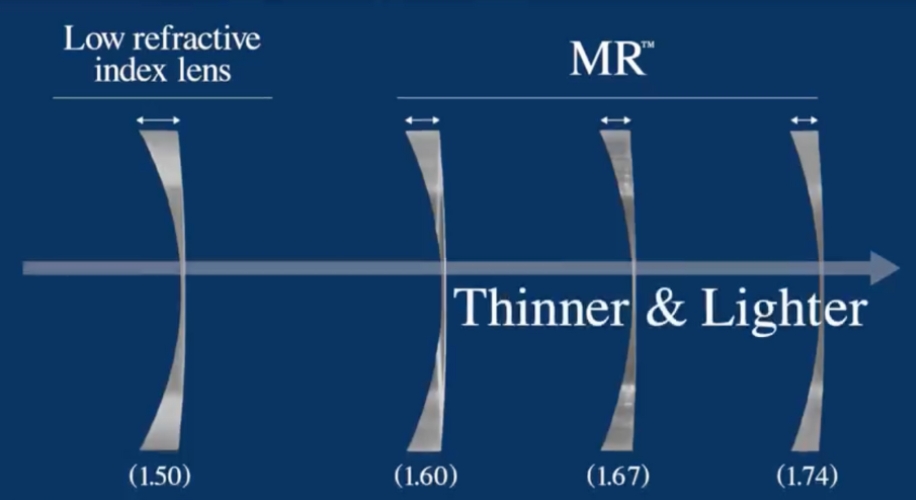
Different Refractive Indexes for High Index Lenses
1.61 Index High Index Lenses
1.61 index lenses represent a common starting point in the high index range. Their material properties allow them to be significantly thinner than standard 1.50 or 1.56 index plastic lenses. This index strikes a good balance between achieving noticeable thinness and maintaining cost-effectiveness for many users.
These lenses are best suited for individuals with moderate prescription strengths. They provide a substantial improvement in aesthetics and weight compared to lower index options for the same prescription. The optical clarity is generally quite good, offering comfortable vision correction.
Features of 1.61 high index lenses include their relatively lightweight nature, contributing to overall comfort during wear. They are a popular choice for those seeking thinner lenses without the higher cost associated with the absolute thinnest options available in 2025.
1.67 Index High Index Lenses
Moving up in refractive index, 1.67 index high index lenses offer further material advantages. They are notably thinner than 1.61 index lenses, making them a widely utilized option for a broader range of prescriptions. The higher index means the lens material bends light more efficiently.
This index is best suited for moderate to strong prescription strengths. For individuals with higher degrees of myopia or hyperopia, 1.67 lenses provide a significant reduction in lens thickness and weight. This is crucial for both comfort and cosmetic appearance, minimizing the visual bulk of the lenses.
Features include a significantly thinner and lighter profile compared to lower indices. This makes eyewear more comfortable to wear for extended periods. The enhanced thinness also contributes to excellent aesthetics, reducing the "bug-eye" or "coke bottle" appearance often associated with strong prescriptions in standard lenses.
1.74 Index High Index Lenses
The 1.74 index represents the highest available refractive index in standard plastic lens materials for eyewear as of 2025. These lenses leverage material properties to achieve maximum thinness and lightness. They are the thinnest option available for those requiring powerful vision correction.
These high index lenses are best suited specifically for strong prescriptions. Individuals with very high levels of nearsightedness, farsightedness, or astigmatism benefit most from 1.74 index lenses. Their ability to significantly reduce lens thickness makes them the premium choice for minimizing the weight and profile of strong corrective lenses.
Features include the maximum potential for thinness and lightness in plastic, providing unparalleled comfort for high prescriptions. While a premium option, 1.74 high index lenses offer the best aesthetic outcome and user experience for those with significant visual acuity needs, ensuring their eyewear is as discreet and comfortable as possible.
Choosing the Right High Index Material
Matching Index to Prescription Strength for High Index Lenses
Selecting the appropriate high index material is crucial for optimizing both the performance and aesthetics of your lenses. High index lenses are generally recommended for individuals with moderate to strong prescription strengths. As a guideline in 2025, prescriptions typically around -4.00 diopters or higher for myopia, and +3.00 diopters or higher for hyperopia, benefit significantly from high index materials.
For moderate needs, a lower high index like 1.61 often provides sufficient thinness and weight reduction. As prescription strength increases, a higher index becomes more beneficial. For stronger needs, 1.67 index lenses offer substantial thinning, while 1.74 index high index lenses provide the maximum available reduction in thickness and weight, making them ideal for very strong prescriptions.
Matching the index correctly ensures the lenses are not only aesthetically pleasing but also optically sound, reducing peripheral distortion. It is highly recommended to consult with an eye care professional to determine the most suitable high index material for your specific prescription, lifestyle, and frame choice. Alternatively, many reputable online platforms offer guides and consultation tools to help you find the right high index lenses. Finding the correct thin lenses is essential for comfort and vision clarity. Explore options for high index lenses to find the perfect fit for your prescription.
【High Index Lenses: Advantages and Disadvantages】
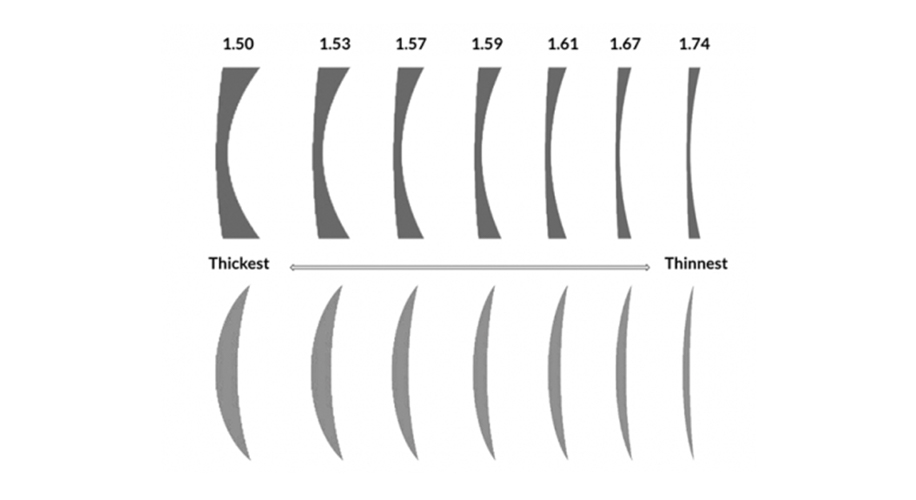
High Index Lenses Benefits
Thinness and Weight Benefits of High Index Lenses
High index lenses offer significant advantages in terms of physical properties, primarily their exceptional thinness and reduced weight compared to standard plastic lenses. This is a key benefit for individuals requiring prescription eyewear in 2025. The material's ability to bend light more efficiently means less material is needed to achieve the correct refractive power.
Thinner lenses are visually appealing, reducing the noticeable bulge or thickness often associated with stronger prescriptions. This aesthetic improvement makes eyewear look more sleek and discreet on the face. It minimizes concerns about the "coke bottle" effect, particularly for those with high levels of nearsightedness or farsightedness.
The lightweight nature of high index lens material directly enhances comfort. Eyeglasses with lighter lenses exert less pressure on the nose bridge and ears, making them easier to wear for extended periods throughout the day. This is crucial for daily comfort and reduces the likelihood of discomfort or fatigue from heavy frames.
Optical Performance of High Index Lenses
Beyond physical attributes, high index lenses can also provide benefits in optical performance. Properly designed high index materials can help reduce optical aberrations. These distortions, such as spherical aberration, can cause blurriness or loss of clarity, especially towards the edges of standard lenses with strong prescriptions.
By minimizing these aberrations, high index lenses contribute to sharper vision and improved clarity across a wider field of view. This enhanced optical precision ensures that vision correction is effective and comfortable, reducing eye strain. The optimized light bending properties lead to a more uniform and clear image for the wearer.
Furthermore, some types of high index materials inherently offer good ultraviolet (UV) protection. Protecting the eyes from harmful UV rays is vital for long-term eye health, preventing conditions like cataracts and macular degeneration. Lenses that include built-in UV filtering provide this essential safeguard without requiring additional lens treatments.
High Index Lenses Disadvantages
Cost Factor of High Index Lenses
One of the primary considerations when choosing high index lenses is the cost factor. High index materials and the manufacturing processes involved are generally more expensive than those used for standard plastic lenses. This translates to a higher price point for high index eyewear.
The initial investment for high index lenses can be significantly greater. While the benefits in terms of thinness, weight, and optics are considerable, the cost difference can be a barrier for some consumers. It is an important aspect to weigh against the desired improvements in comfort and aesthetics.
Moreover, high index lenses often require additional coatings to optimize their performance and durability. Essential treatments like anti-reflective (AR) coatings are highly recommended, and scratch-resistant coatings are standard. These necessary additions contribute to the overall cost of the lenses, potentially increasing the final price tag further.
Potential for Reflections with High Index Lenses
Higher refractive index materials tend to reflect more light from the lens surface than lower index materials. This increased reflection can be a notable disadvantage if not properly managed. Reflections can be distracting to the wearer and also visible to others looking at the glasses.
Internal and external reflections can reduce the amount of light entering the eye, potentially affecting vision clarity, especially in certain lighting conditions. Glare from lights or screens can be more pronounced. This issue makes the application of a high-quality anti-reflective coating almost mandatory for high index lenses to ensure optimal visual performance and aesthetics by minimizing these reflections.
Another potential optical issue with some high index materials, particularly in higher powers, is chromatic aberration. This phenomenon causes different wavelengths of light (colors) to be bent at slightly different angles, leading to color fringing around objects, especially towards the periphery of the lens. While modern designs and materials have improved this, it remains a potential factor in the overall optical quality for some individuals. Choosing high quality materials and designs for your thin lenses helps mitigate these issues. Exploring options for your specific needs is key to finding the best solution. Compare different high index lenses to understand the trade-offs and benefits.
【High Index Lenses vs. Other Lens Materials】
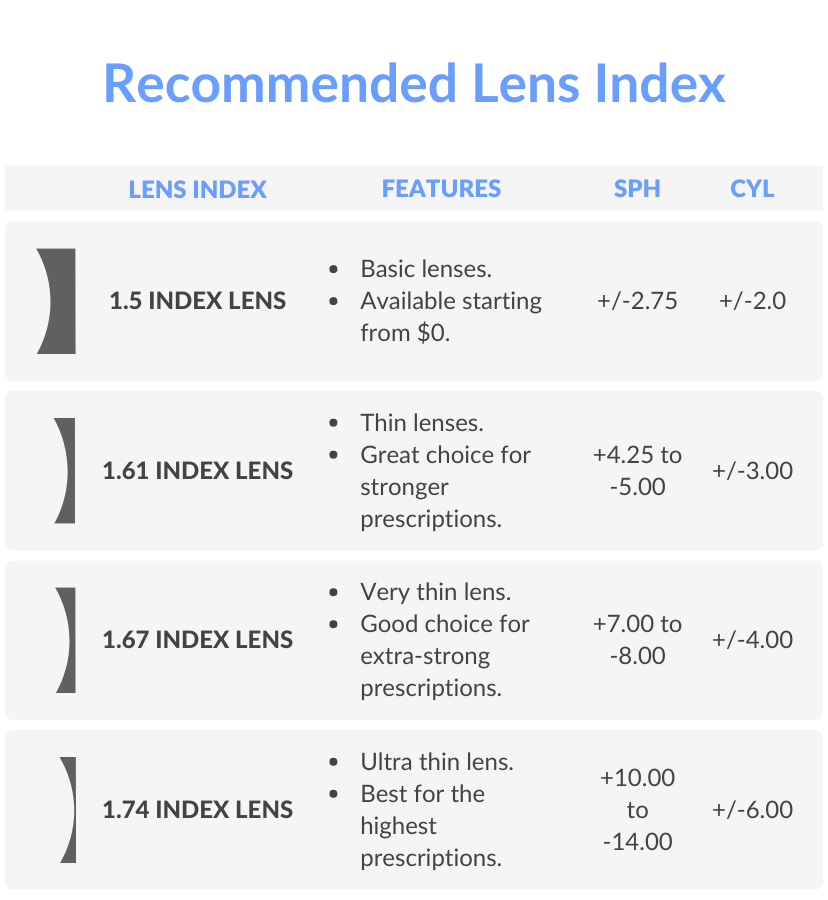
High Index Lenses vs. Polycarbonate
Impact Resistance
Polycarbonate is widely recognized for its exceptional impact resistance. This property makes it a preferred material for safety glasses, children's eyewear, and sports lenses in 2025. Its ability to withstand significant force without shattering provides a high level of eye protection against physical impact.
High index lens materials also offer good impact resistance, meeting standard safety requirements for everyday eyewear. However, when compared directly, polycarbonate generally demonstrates a superior capability to absorb energy from impacts. While suitable for most prescriptions, high index materials may not be the first choice for demanding sports or occupations requiring maximum impact protection.
Optical Clarity
In terms of optical performance, high index lenses often surpass polycarbonate, particularly concerning clarity and minimizing distortion. Standard polycarbonate can sometimes exhibit higher levels of chromatic aberration, a phenomenon where different colors of light are refracted differently, leading to noticeable color fringing around objects, especially towards the lens periphery.
High index materials, especially those with higher Abbe numbers, can offer better control over light dispersion, resulting in clearer vision and reduced chromatic aberration. This provides a sharper, more precise visual experience for the wearer across the entire lens surface. The improved optical quality is a significant advantage for those seeking the clearest possible vision correction.
Best Material for High Index Lenses
Material Composition
The term "high index lenses" refers not to a single material but to a category of materials characterized by their high refractive index. These materials include various types of specialized plastics, such as MR-series resins, which possess distinct properties influencing lens performance. Glass can also be high index, though plastic is more common for its weight and safety advantages in 2025.
When evaluating high index materials, the Abbe number is a critical factor to consider. This number measures the material's dispersion of light, directly impacting chromatic aberration. A higher Abbe number indicates lower dispersion and thus better clarity, with less color fringing. Selecting a high index material involves balancing a high refractive index for thinness with a sufficiently high Abbe number for optical clarity.
Ongoing research continues to explore new materials to push the boundaries of lens technology. For example, advancements include solution processes for creating ultrabroadband and omnidirectional graded-index glass lenses. These materials aim for near-zero reflectivity and potentially revolutionary optical performance, highlighting the continuous evolution in high index lens composition.
Index of Refraction
The defining characteristic of high index lenses is their elevated index of refraction. This optical property dictates how efficiently the material bends light; a higher index means more bending power, allowing for thinner lenses for a given prescription. Indices typically range from 1.59 (often considered the lower end of high index, like polycarbonate) up to 1.74 or even higher.
Choosing the "best" high index material involves more than just seeking the highest index number for maximum thinness. It requires a careful balance of the high refractive index with other crucial factors. These include the material's Abbe number to ensure good optical clarity, its specific gravity (density) which affects the final weight of the lens despite thinness, and its impact resistance for durability and safety. The ideal choice of high index lens material depends on an individual's prescription, lifestyle, and visual needs. Finding the right balance of properties is key for optimal vision and comfort. Find the right high index lenses by comparing options based on these factors.
【Choosing the Right High Index Lenses】
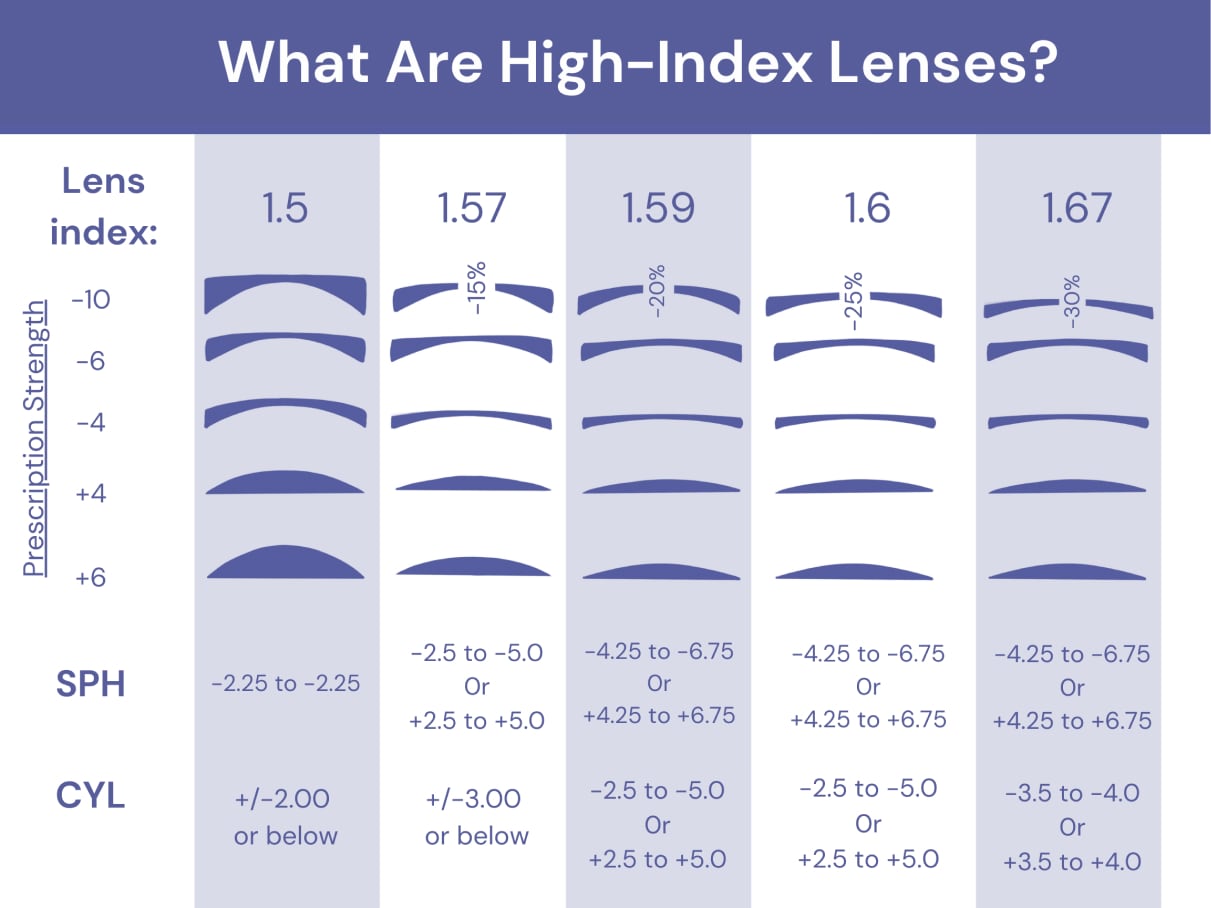
Are High Index Lenses Worth It?
Prescription Strength
The value of high index lenses is significantly influenced by your prescription strength. For individuals with strong prescriptions, these lenses offer substantial benefits. They dramatically reduce the thickness and weight compared to standard lens materials, leading to more comfortable and aesthetically pleasing eyewear.
Conversely, for mild prescriptions, the difference in thickness and weight when using high index materials is less pronounced. Standard plastic or polycarbonate lenses may provide sufficient thinness and be a more cost-effective option. The decision often depends on whether the marginal improvement in cosmetic appearance justifies the higher cost for lower prescription strengths.
Lifestyle Considerations
Your lifestyle plays a crucial role in determining if high index lenses are the optimal choice. If you lead an active lifestyle, considering the impact resistance of the specific high index lens material is important. While generally durable for everyday use, some activities might benefit more from materials like polycarbonate, known for superior impact protection in 2025.
For those concerned with fashion preferences and aesthetics, the reduced thickness of high index lenses can significantly enhance the appearance of your eyewear. Thinner lenses fit better into a wider range of frame styles, including delicate or rimless designs. They also minimize the "bug-eye" or "coke bottle" effect often associated with thick conventional lenses for strong prescriptions.
How to Choose High Index Lenses
Consultation with an Eye Care Professional
The first and most critical step in selecting high index lenses is a comprehensive consultation with a qualified eye care professional. A recent and accurate eye exam is essential to determine your precise prescription and assess your overall vision needs.
An optometrist or ophthalmologist can provide professional advice tailored to your specific situation. They can guide you through the various high index lens materials available, explaining the differences in refractive index, Abbe number, density, and recommended coatings. Their expertise helps ensure you select lenses that offer optimal vision correction, comfort, and durability.
Frame Selection
Choosing the right frame is vital when opting for high index lenses. Because these lenses are significantly thinner, especially at the edges for minus prescriptions or the center for plus prescriptions, frame compatibility is key for both aesthetics and performance. Certain frames, like semi-rimless or rimless styles, may require specific lens materials or edge treatments.
Consider the size and style of the frame. Smaller frames can help minimize lens thickness further, particularly for high minus prescriptions. The frame design should complement the thinner profile of high index lenses for the best cosmetic outcome. Discussing your frame preferences with your optician ensures the perfect match between your high index lenses and your chosen eyewear. To find lenses that fit your vision needs and pair well with various frames, explore compatible options based on material properties and frame types.
【Purchasing High Index Lenses】

Once you have consulted with an eye care professional and considered frame options, the next step is acquiring your high index lenses. This involves understanding the associated costs and exploring the various purchase avenues available in 2025. Making an informed decision about where and how to buy ensures you get the best value and suitable eyewear.
High Index Lenses Cost
Understanding the financial investment required for high index lenses is essential for budgeting. Several factors contribute to the final price of these advanced lenses. Their specialized manufacturing process and material properties inherently make them more expensive than standard plastic or polycarbonate options, especially for higher prescriptions.
Factors Influencing High Index Lenses Cost
The price of high index lenses is not uniform; it varies based on several key elements. One significant factor is the specific material index chosen (e.g., 1.67, 1.74). Higher index materials, which provide maximum thinness and lightness for strong prescriptions, are generally more costly due to the complexity of their composition and production.
Additional lens treatments also add to the overall high index lenses cost. Premium anti-reflective coatings, crucial for minimizing glare and improving clarity, are standard additions. Scratch-resistant coatings enhance durability, while UV protection safeguards eye health. These essential coatings, while increasing the price, significantly improve the performance and lifespan of your thin lenses.
Furthermore, the brand and retailer from which you purchase your high index lenses will impact the price. Established lens manufacturers often command higher prices for their proprietary technologies and quality control. Similarly, different optical retailers, whether brick-and-mortar stores or online platforms, have varying pricing structures based on their overheads, services offered, and market positioning.
Cost-Saving Tips for High Index Lenses
While high index lenses represent a higher initial investment, there are strategies to manage the cost. Exploring different purchasing channels can lead to significant savings without compromising on quality or the benefits of thinner, lighter lenses.
Consider leveraging the competitive pricing offered by online retailers. Many reputable online glasses stores provide high index lenses online at lower prices compared to traditional brick-and-mortar stores, often due to lower operating costs. Comparing prices across different online platforms can help you find cost-effective options for your required prescription and lens index.
Another crucial step is checking your vision insurance coverage. Many vision insurance plans cover a portion of the cost of prescription eyewear, including specialized lenses like high index lenses. Understanding your plan's benefits, including allowances for lenses and coatings, can substantially reduce your out-of-pocket expenses for your new glasses in 2025.
Where to Buy High Index Lenses
Choosing the right vendor is as important as selecting the high index lens material itself. Both online retailers and local opticians offer distinct advantages when purchasing these specialized lenses. Your decision may depend on your preference for convenience, cost, or personalized service.
Online Glasses Stores for High Index Lenses
Purchasing high index lenses online offers convenience and competitive pricing, making it an attractive option for many customers in 2025. Online retailers often have extensive selections of frames and lens options, including various high index lens materials and indices. The ease of browsing and ordering from home is a significant benefit.
Many online platforms specializing in eyewear provide tools to assist customers. Utilizing virtual try-on features allows you to see how frames might look on you, complementing the thin profile of high index lenses. Detailed descriptions of lens options, including refractive index, coatings, and recommended prescription ranges, help in making an informed decision when buying your prescription lenses online. To find a wide selection of high index lenses options at competitive prices, explore online selections that detail different materials and coatings available for your prescription needs.
Local Opticians for High Index Lenses
Opting to buy your high index lenses from a local optician provides a level of personalized service and expert guidance often preferred by some customers. Local optical shops offer the advantage of in-person consultations with experienced professionals who can provide tailored advice based on your specific prescription, face shape, and lifestyle needs.
Local opticians can perform precise measurements, such as pupillary distance and optical center, which are critical for the correct placement and performance of high index lenses, especially with strong prescriptions. They also provide essential follow-up services like frame adjustments and fittings, ensuring optimal comfort and clarity. This hands-on approach guarantees your eyewear fits perfectly and provides the best possible vision correction with your new thin lenses.
【Maintaining and Caring for High Index Lenses】

Proper maintenance and care are crucial for maximizing the lifespan and performance of your high index lenses. These specialized lenses, while thin and lightweight, still require attention to remain clear, scratch-free, and fully functional. Understanding the best practices for cleaning and storage ensures your investment provides optimal vision correction for years to come in 2025.
High Index Lenses Durability
The inherent durability of high index lenses depends on the specific material and the protective treatments applied. While designed for thinness, the base material properties and subsequent coatings significantly influence how well the lenses withstand daily wear and tear. Caring for them correctly helps preserve their integrity.
Material Properties
Different high index lens materials exhibit varying levels of resistance. Materials like Trivex or certain polyurethane-based indices may offer better impact resistance compared to standard resin options. This is a key consideration for individuals with active lifestyles. Scratch resistance also varies; while no lens material is entirely scratch-proof, some are naturally harder than others. Always inquire about the specific properties of the material chosen for your prescription lenses.
Lens Coatings
Lens coatings are essential for enhancing high index lenses durability and performance. A factory-applied scratch-resistant coating is virtually mandatory to protect the surface from minor abrasions that can occur during cleaning or handling. Furthermore, high-quality anti-reflective coatings not only improve visual clarity by reducing reflections but also add a layer of protection to the lens surface. These coatings are vital for preserving the optical quality of your thin lenses.
High Index Lenses Scratch Resistance
Maintaining the high index lenses scratch resistance is paramount to ensuring clear vision. Scratches, even small ones, can significantly distort light and impair the effectiveness of your lenses. Implementing proper cleaning and storage habits is the most effective way to prevent damage.
Proper Cleaning Techniques
To clean your high index lenses without causing scratches, always start by rinsing them under lukewarm water to remove loose debris. Use a lens cleaning solution specifically designed for eyeglasses; avoid household glass cleaners, ammonia-based products, or solvents, as these can damage lens coatings. Dry the lenses gently using a clean, lint-free microfiber cloth. Rubbing aggressively or using paper towels can introduce fine scratches onto the prescription lenses surface.
Storage
When you are not wearing your thin lenses, storing them correctly is vital for preventing scratches. Always place your eyeglasses in a protective case, preferably a hard-shell case that prevents them from being crushed or coming into contact with other objects. Avoid leaving glasses lens-down on any surface. Contact with rough or abrasive surfaces, even briefly, can easily create permanent scratches on the high index lenses.
【Specific Applications of High Index Lenses】
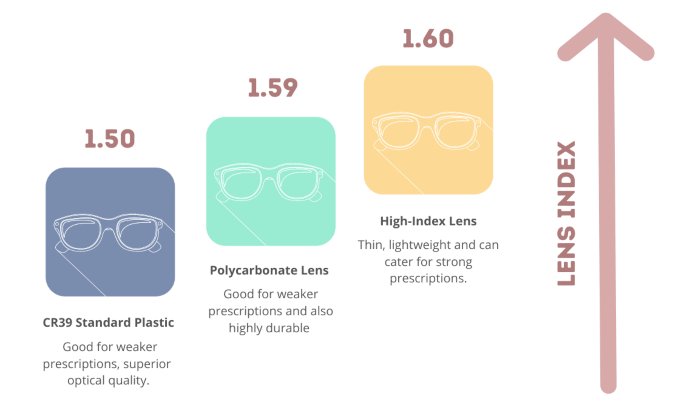
High index lenses offer distinct advantages tailored to various vision correction needs. While beneficial for many wearers, their properties are particularly impactful for individuals with strong prescriptions or complex refractive errors like astigmatism. Understanding these specific applications helps demonstrate why high index lenses are often the preferred choice in 2025.
High Index Lenses for Strong Prescriptions
Individuals with significant refractive errors, such as high myopia (nearsightedness) or hyperopia (farsightedness), traditionally faced the issue of thick, heavy lenses. High index lenses for strong prescriptions are specifically engineered to mitigate these problems, providing a more aesthetically pleasing and comfortable eyewear solution.
Benefits
A primary benefit of choosing high index lenses for strong prescriptions is the significant reduction in lens thickness. This is essential for high myopic or hyperopic prescriptions where standard lens materials would result in very thick edges or centers. Additionally, the reduced material volume inherent in thin lenses directly leads to lighter eyeglasses, which substantially improves comfort for wearers with significant refractive errors throughout the day in 2025.
Lens Design
Beyond material composition, the lens design plays a crucial role in optimizing high index lenses for strong prescriptions. Consider aspheric lenses; these designs have a flatter curve than traditional spherical lenses, which further helps to minimize lens thickness and reduce peripheral distortion often associated with high power prescription lenses. For optimal visual performance and comfort, opting for customized lens designs can account for individual frame fit and eye position, providing superior clarity. Finding high index lenses designed for high prescriptions is crucial for managing significant refractive errors. To explore options tailored for significant refractive errors and improved cosmetics, check high index lenses.
High Index Lenses for Astigmatism
Astigmatism is a common refractive error where the eye does not focus light evenly onto the retina, often due to an irregularly shaped cornea. Correcting astigmatism requires lenses with different powers along different meridians. High index lenses for astigmatism can provide precise and effective correction.
Correction Capabilities
High index lenses are highly effective in correcting astigmatism, ensuring that light is focused correctly across all meridians of the eye, thereby providing clear and sharp vision correction. Accurate cylinder power in the prescription is paramount; this measurement defines the degree of astigmatism and the axis where it occurs. High index materials allow for the precise grinding required to incorporate this cylinder power accurately without excessive thickness, even for higher degrees of astigmatism.
Lens Options
Discussing specific lens options with your eye care professional is key for enhanced astigmatism correction. Toric lenses are the standard design used to correct astigmatism, featuring a toroidal surface that has different powers in different meridians. High index lenses can be manufactured with toric lens surfaces efficiently. For complex astigmatism cases or specific visual needs, exploring custom lens designs might be beneficial, offering tailored astigmatism correction for optimal visual acuity. Ensuring clear vision with astigmatism requires precise lens options. To find high index lenses suitable for correcting astigmatism and explore these specific designs, discover high index lenses.
【Brands and Reviews】

Selecting the right high index lenses often involves researching available brands and consumer experiences. Understanding the landscape of lens manufacturers and gathering insights from reviews can significantly influence the final choice of eyewear in 2025. This section explores key industry players and how expert and user feedback contribute to making an informed decision about thin lenses.
High Index Lenses Brands
The market for high index lenses is dominated by several established companies known for their quality and optical technology. Choosing a reputable brand is essential for ensuring the performance and durability of your prescription lenses.
Key Manufacturers
Several key manufacturers specialize in developing advanced ophthalmic lenses, including high index materials. Tokai, a Japanese lens manufacturer, focuses heavily on improving the quality of life for wearers, emphasizing quality of light and the quality of lenses. Their approach often involves unique product features. Essilor is recognized as a global leader in the ophthalmic lens industry, renowned for its continuous innovation and commitment to high standards of quality across its product lines, including thin, lightweight lenses. Zeiss is another prominent name, offering precision lenses built on advanced optical technologies, ensuring exceptional visual clarity and performance. These brands represent the forefront of high index lens development.
Brand Reputation
Researching brand reputation provides valuable context when considering high index lenses. It involves examining customer feedback and ratings across various platforms to understand user satisfaction levels. Brands known for their technological advancements often lead the market in providing superior lens designs and coatings that enhance visual acuity and lens longevity. A strong reputation typically indicates consistent quality and reliable product performance. Gathering this information helps potential buyers gauge the reliability and effectiveness of a high index lens brand before making a commitment.
High Index Lenses Review
Beyond brand names, understanding the real-world performance of high index lenses through reviews is crucial. This involves consulting various sources to get a comprehensive view of how these thin lenses perform in daily use.
Expert Opinions
Consulting expert opinions is a vital step in the high index lenses review process. Eye care professionals, such as optometrists and opticians, can provide recommendations and insights based on their clinical experience and knowledge of different lens materials and designs. Their expertise is invaluable, especially for complex prescriptions or specific visual needs. Additionally, exploring online forums and communities where eye care professionals and experienced lens wearers discuss high index lenses can offer practical perspectives and address common concerns about optical performance and comfort.
Personal Experiences
Gathering information about personal experiences provides a different, yet equally important, perspective in a high index lenses review. Many optical providers offer trial periods or have favorable return policies that allow users to assess lens performance in their own environment. Looking for user testimonials and case studies offers insights into how high index lenses have worked for others with similar prescriptions or lifestyles. These real-world accounts can help manage expectations regarding adaptation, comfort, and visual outcomes when switching to or purchasing high index lenses. For individuals seeking lightweight lenses or managing a strong prescription, reviewing shared experiences can be highly informative.
Choosing Your Ideal High Index Lenses
In summary, selecting the right "high index lenses" hinges on understanding their different indices (1.61, 1.67, 1.74) and how they cater to varying prescription strengths. While offering compelling benefits like reduced thickness and weight, and improved optical clarity with proper coatings, it is essential to weigh these against potential drawbacks such as higher cost and reflections. Comparing "high index lenses" to materials like polycarbonate reveals trade-offs in impact resistance versus optical purity. Ultimately, the best choice involves balancing material properties like refractive index and Abbe number with personal needs.
Making an informed decision requires consulting an eye care professional, considering your lifestyle, and carefully selecting a frame that complements your "thin lenses". Understanding pricing factors and exploring reputable online and local purchasing options are also key steps. With correct maintenance, including proper cleaning techniques and careful storage, your "high index lenses" will provide lasting comfort and clear vision. Whether addressing "strong prescriptions" or "astigmatism," "high index lenses" offer tailored solutions through advanced designs like aspheric and toric lenses from leading "brands" like Tokai, Essilor, and Zeiss. Researching "reviews" and "personal experiences" further guides your choice for optimal "eyewear" in 2025.
Ready to experience the difference "thin lenses" can make? Explore a wide selection of "high index lenses" tailored for various prescriptions and frames. Click here to discover the perfect "high index lenses" for your vision needs and help support this content at [https://www.mozaer.com/search?q=high index lenses](https://www.mozaer.com/search?q=high index lenses). Share your thoughts below or pass this article along to someone considering an upgrade to "high index lenses"!
Comments
Post a Comment